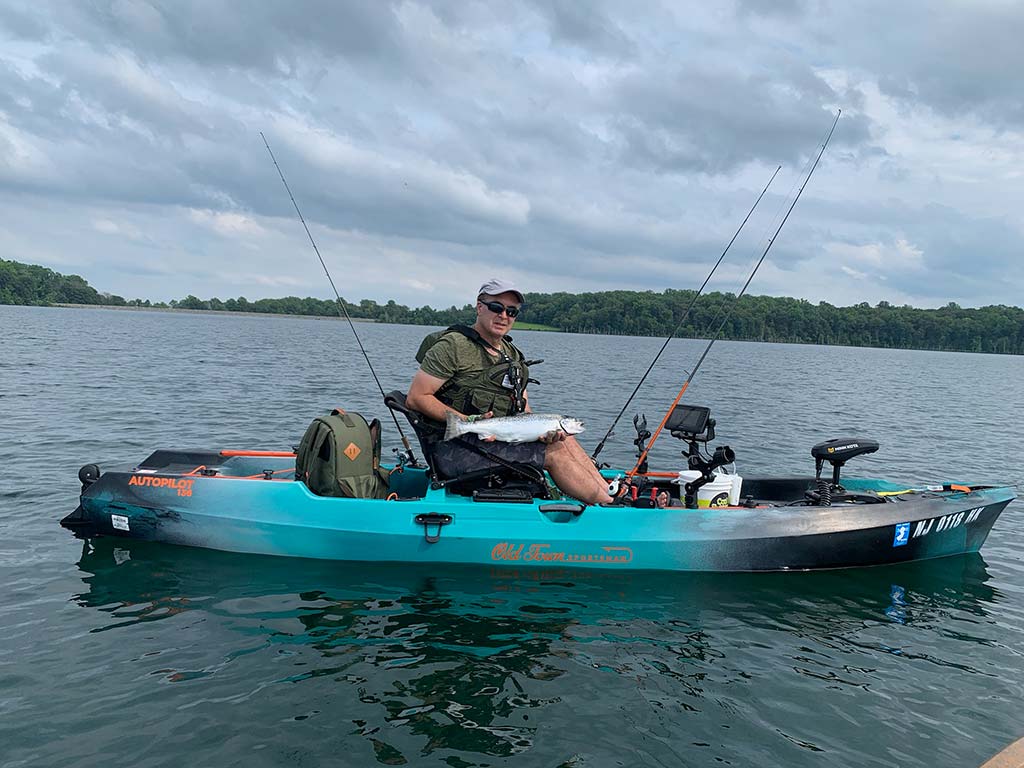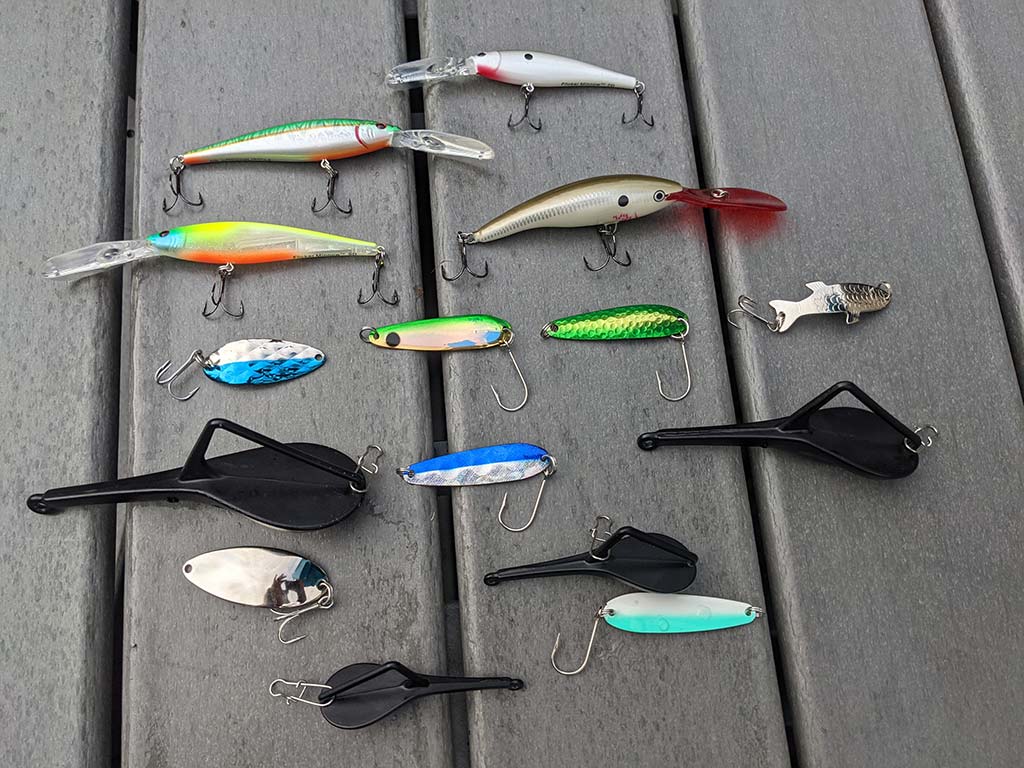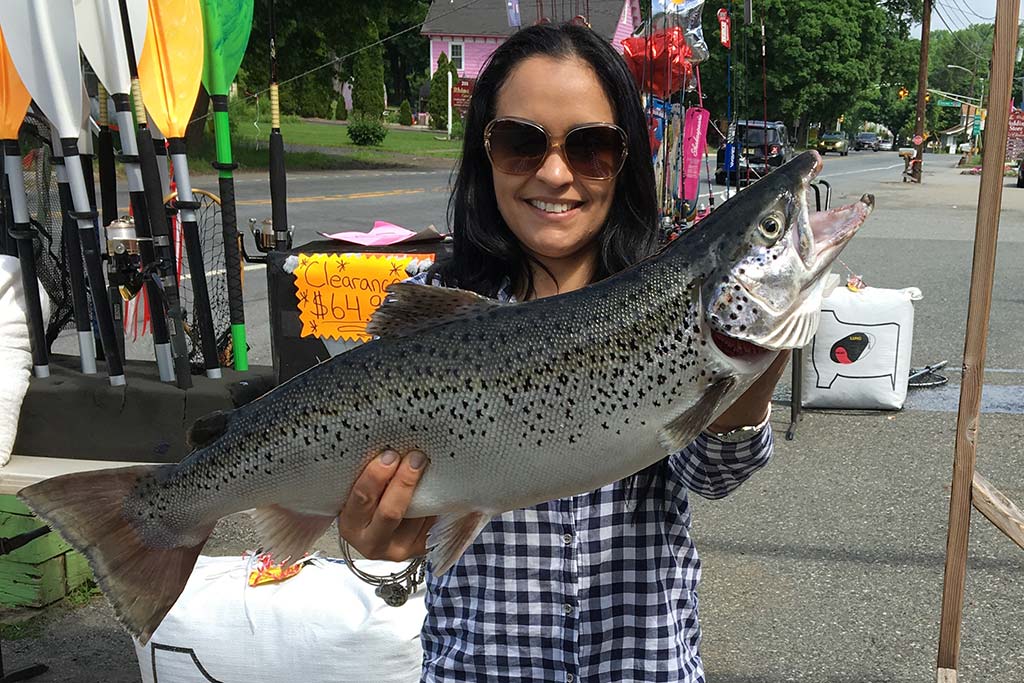How to land New Jersey’s youngest freshwater gamefish.
New Jersey’s landlocked salmon fishery began 15 years ago when the New Jersey Division of Fish and Wildlife first sourced 7- to 8-inch salmon from hatcheries in Massachusetts and stocked them in Lake Wawayanda and Aeroflex (formerly known as New Wawayanda Lake). The fishery grew and expanded to Tilcon Lake around 2013, then most recently in 2018 at Merrill Creek Reservoir, with these impoundments now receiving allocations of landlocks annually in the fall months.
Each of these lakes and reservoirs can sustain a landlocked salmon fishery, yet each is interesting in their own right. As someone who fished in reservoirs for trout on a regular basis (often to the point of obsession), I’ve fished them all and find each water body requires a different approach.
The lakes and reservoirs where anglers can find salmon in New Jersey share a lot in common. First, they all offer boating, but they all limit propulsion to no more than electric motors. Many, including Tilcon, Wawayanda and Merrill Creek, are only open during daylight hours (although the gate at Wawayanda is left open for those camping in case they need to get out for any reason). Only Lake Aeroflex is open 24 hours.
These water bodies are also are very deep – over 50 feet – and have rich, oxygenated water that can support good populations of alewives, along with cold water that can support salmon.

Landlocked Lineup
Lakes Wawayanda and Aeroflex are similar in their makeup. Lake Wawayanda’s 255 acres is two deep bowls separated by a shallow section of water and an island; at only 105 acres, Lake Aeroflex also has two deep bowls separated by a shallow section of water, but the bowls are smaller (as is the shallow section of water). In the fall, winter, and spring, salmon will be dispersed anywhere. In the summer, landlocked salmon will be in the deep bowls, at or even below the thermocline.
Lake Tilcon is the smallest of the impoundments that holds landlocked salmon, but it is quite interesting. Located in Allamuchy State Park, the 88-acre lake was created in 2000 when 14 inches of rain flooded the banks of the neighboring Musconetcong River, sending a wall of water downstream from its headwaters at Lake Hopatcong and into the quarry owned by the Tilcon Company. Lore has it that the lake has mining equipment at its bottom, but no one can confirm this.
Accessing Tilcon requires anglers to walk over one hundred yards and through a steel gate, making launching larger watercraft an impossibility. Neighboring Stanhope Township has dropped gravel in areas around the lake and hopes to offer more convenient parking for cartops, but this has not yet become a reality. Kayakers and canoers who own a cart can enjoy pristine fishing, often with the company of only one or two other anglers.
The lake itself has two deep sections, one up to 45 feet near the launch. Its deepest section is at the far end of the lake where depths are over 50 feet. While there are many shallow lumps throughout, these deep sections are where anglers should fish in warmer months, while trolling the entire lake in the cooler months will produce.
Merrill Creek Reservoir is the largest landlocked salmon body at 650 acres and is the most recent recipient of salmon. My favorite New Jersey body of water, Merrill Creek is also the deepest body of water with depths to 200 feet. The unforgiving reservoir sends many an angler home skunked, but this is a reservoir of dreams, housing smallmouth bass exceeding 7 pounds, and an amazing lake trout fishery.
Being a new fishery, Merrill Creek has significant promise for creating a world class landlock fishery. The reservoir has large quantities of alewives while the vast expanse of depth ensure that abundant clear, clean water abounds. Merrill Creek’s drawback is that the impoundment is owned by a consortium of power companies that closely manages the property; the gate to fish the reservoir opens at sunrise and closes one half hour before sunset, robbing anglers of the opportunity to fish for salmon and other species during prime fishing hours. In fact during the height of the pandemic Merrill Creek was closed for three months, restricting anglers from accessing a world class fishery.

Fresh Fall Trolling
The state stocks each impoundment in the fall, usually starting in mid-October. By early November, stocking is complete as reservoirs and Lakes receive an allotment of 11- and 15-inch landlocks. In the past, Merrill Creek reservoir has received only 15-inch landlocked salmon, but large quantities. This fall stocking provides an opportunity for anglers to catch large salmon that often exceed 3 pounds from fall through winter into spring and summer.
Salmon are pelagic fish being that they do not hold in structure and will roam open water in search of prey. They prefer cool water (below 65 degrees) and can be found anywhere in the impoundments, particularly in the cooler months through early spring. As spring progresses and waters warm, landlocks will head deeper, at or below the thermocline.
As salmon can be found just about anywhere in the water, most anglers prefer to troll for them. Trolling around points and major temperature changes is often effective, depending on time of year. As the water cools in the fall, then into ice out and in the spring, fishing the shallows and below the surface is most effective. While fishing from shore may produce, the angler who can troll, can cover much more ground and expose their offering to more fish. Through the cooler months, fish will stay close to the surface and can easily fall to prey to varied offerings.
Some top lures to use for landlocked salmon include plugs and spoons. I use diving plugs that emulate alewife, including the Rapala X-Rap and Berkley Flicker minnow. Depending on time of year, I’ll use varying diving depth lures that range anywhere from 5 to 25 feet. These plugs can be trolled anywhere from 1.5 to 3 miles per hour, with my normal comfort zone being 2.3 mph.
When fishing spoons and spinners, I work to emulate the size of alewives, ideally in the 2- to 4-inch range. My favorites include Phoebes and Acme Little Cleos, but I have found numerous smaller brands that provide great spoons as well. The Thomas Lures Speedy Shiner is a consistent landlocked lander and a favorite of New England anglers.

Digging Deeper
As many spoons are light, trolling under the surface can be challenging. To adapt, I’ll add a tool created by Off Shore Tackle called the Tadpole that helps get spoons down to the depths that I want. The Tadpole is a simple version of a dipsy diver that attaches to the line approximately 3 to 5 feet above their lure. The diver comes in a variety of sizes, from sizes 1 to 3 and a Magnum size. Smaller sizes weigh less and dive shallower depths, but I find trolling with the Tadpoles anywhere between 1.5 and 3 mph to prove successful.
The Tadpoles all work on the same principle; there are two positions to use the diver, either diving or retrieving. When in the diving position, the Tadpole will dive to its anticipated depth, provided the appropriate amount of line is released. When a fish hits, the swivel which holds the Tadpole and goes to the angler’s rod simply moves into a retrieve position, limiting resistance and allowing the Tadpole to be retrieved easily. The angler can now directly fight the fish with minimal resistance.
When fishing for landlocks, I use a 7-foot medium heavy casting rod paired with an Ambassadeur 5500 or equivalent. Since I’m usually trolling to cover ground and find fish, I’ll use at least two, if not three rods, keeping them at multiple depths. In the fall, I’ll use the lightest Tadpoles just to get my line down below the surface and not skipping on the surface. To gauge depth, I will let out approximately 30 feet of line; the diving Tadpoles are visible through my depthfinder so I can see how deep my lures are before letting out more line. This ensures that I know the relative depth of my lures.
Bait also is effective for landlocked salmon, like alewife and herring. I like to fish with herring once I have located fish on either my depthfinder or have landed numerous fish in an area. I find a size 2 hook tied 12 to 18 inches of line above a barrel swivel with just enough weight to keep the minnow suspended at the desired depth to be most effective.
Landlocked fishing is exciting and a great way to fish through fall, winter and even spring into summer. Each of the state’s impoundments offering landlocks offers something different for the angler, but in particular the opportunity for New Jersey anglers to land these elusive and hard fighting salmon.





